Do you want to learn everything about SEO? Before I teach you how it works and how to do it, let’s first go over the definition of SEO, and then we will dive into how SEO works.
What Is SEO?
SEO stands for search engine optimization. SEO is the process of taking steps to help a website or piece of content rank higher on Google.
The key difference between SEO and paid advertising is that SEO involves “organic” ranking, which means you don’t pay to be in that space. To make it a bit simpler, search engine optimization means taking a piece of online content and optimizing it so search engines like Google show it towards the top of the page when someone searches for something.
Look at it this way. When someone types “vegan lasagna” into Google, they’re likely looking for a recipe, ingredients, and instructions on how to make it. If you wrote an article about making vegan lasagna, you’d want people to find your recipe. For anyone to find it, you need to rank above all the other websites with recipes for vegan lasagna. It’s not easy, but that’s what SEO marketing is all about.
Let’s break it down even further: The majority of online searches begin with a search engine like Google. In fact, 75 percent of those searches start on Google.
To better understand how you can rank your content higher in the search engines, you need to first understand how search works.
The ultimate goal of this article is to help you understand the ins and outs of search so you can optimize your content to rank higher on Google and get more eyeballs on your posts.
Core Elements of SEO: On-Page SEO and Off-Page SEO
When it comes to broader SEO, there are two equally important paths: on-page SEO and off-page SEO.
On-page SEO is about building content to improve your rankings. This comes down to incorporating keywords into your pages and content, writing high-quality content regularly, making sure your metatags and titles are keyword-rich and well-written, among other factors.
Off-page SEO is the optimization happening off of your website itself, such as earning backlinks. This part of the equation involves building relationships and creating content people want to share. Though it takes a lot of legwork, it’s integral to SEO success.
SEO Strategies: Black Hat Vs. White Hat
I’ve always played the long-term entrepreneurial game, and I believe it’s the way to go. However, this isn’t the case with everyone. Some people would rather take the quick gains and move onto something else.
When it comes to SEO, going for quick gains is often referred to as “black hat SEO.” People who implement black hat SEO tend to use sneaky tactics like keyword stuffing and link scraping to rank quickly. It might work for the short-term and get you some traffic to your site, but after a while, Google ends up penalizing and even blacklisting your site so you’ll never rank.
On the other hand, white hat SEO is the way to build a sustainable online business. If you do SEO this way, you’ll focus on your human audience.
You’ll try to give them the best content possible and make it easily accessible by playing according to the search engine’s rules.
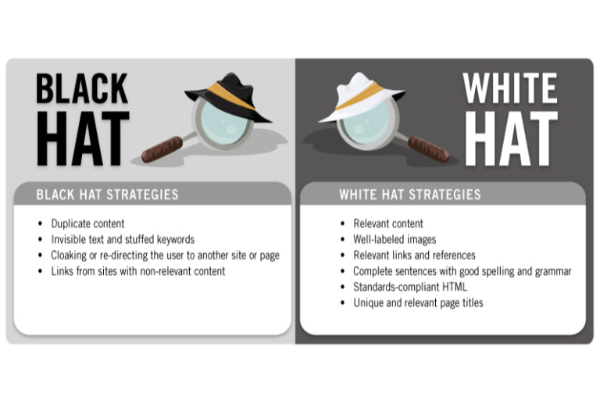
This image from Inbound Marketing Inc. does an exceptional job of breaking it down, but let me shine some additional light on these topics:
- Duplicate content: When someone tries to rank for a certain keyword, they might duplicate content on their site to try and get that keyword in their text over and over again. Google penalizes sites that do this.
- Invisible text and keyword stuffing: Years ago, a black hat strategy was to include a ton of keywords at the bottom of your articles but make them the same color as the background. This strategy will get you blacklisted very quickly. The same goes for stuffing in keywords where they don’t belong.
- Cloaking and redirecting: When it comes to redirects, there’s a right and wrong way to do it. The wrong way is buying up a bunch of keyword-rich domains and directing all the traffic to a single site.
- Poor linking practices: Going out and purchasing a Fiverr package promising you 5,000 links in 24 hours is not the right way to build links. You need to get links from relevant content and sites in your niche that have their own traffic.
Since Google penalizes sites that do these things, you’ll only hear me talk about white hat SEO.
There is such a thing as gray hat SEO, though. That means it’s not as pure or innocent as the whitest of white hats, but it isn’t quite as egregiously manipulative as black hat techniques can be. You’re not trying to trick anyone or intentionally game the system with gray hat. However, you are trying to get a distinct advantage.
See, Google’s standards aren’t as clear-cut as they’d like you to believe. Many times, they might even say contradictory things. For example, Google has said they’re not a fan of guest blogging to build links.
Now, what about guest blogging to grow your brand? What if you do it to build awareness, generate high-quality traffic back to your site, and become a household name in the industry?
In the SEO world, it’s not so much about what you do but how you do it. If you’re purchasing guest posts on sites that have nothing to do with your niche and spamming a bunch of links, you’re going to get penalized. If you’re creating unique guest posts that provide value to readers on sites that are relevant to you, you’ll be fine, and the link juice will flow nicely to your site.
SEO Marketing Basics: The Complete Breakdown
Now it’s time to learn how to do SEO marketing. Understanding it is one thing, but SEO requires a lot of action and time. This is not something you can make a change to today and expect to see results tomorrow. SEO takes daily actions with the goal of long-term success.
Content
You’ve probably heard it before: “Content is king.” Bill Gates made this prediction in 1996, and it’s as true as ever today.
Why?
Because a Google user is happy when they find the result that serves their needs in the best way.
When you Google “quick and easy homemade mac and cheese,” Google puts all its energy into delivering to you what Google believes is the best recipe for homemade mac and cheese (that takes little time and uses few ingredients) on the entire web.
It doesn’t look for just the quickest recipe, just the easiest recipe, or throw out a bunch of online shops for frozen dinners. It tries to give you exactly what you asked for. Google always tries to provide the best experience possible by directing you to the greatest content it can find.
This means your number one job to do well with SEO is to produce great content.
That’s a bummer, right? You still have to put in a ton of work. SEO is no different than any other skill: great results come from big effort. Just like the best marketing in the world won’t help you sell a bad product, super advanced SEO is useless if you don’t have quality content.
Elements of Content
There are a million elements that go into creating high-quality content; here are a few of my most crucial ones:
Quality
Once, posting a piece of content with a bunch of keywords was the standard. If you were creating quality content that actually solved someone’s problem, you were a standout, and that made it easy to rank.
Today, content is much better, and many online businesses have blogs they use to add value to their site and rank higher on Google.
Coming up with great content isn’t easy, but the good news is, you don’t always need to create your content from scratch. You can piggyback off of what others have created but simply add more value and make your piece of content more in-depth.
The bottom line is that your content needs to solve a problem or provide a solution to whatever brings the reader to your post. If it doesn’t, they’ll quickly click away from your page, telling Google your piece of content isn’t solving anyone’s problem.
Intent
Google puts a lot of emphasis on intent. It wants to understand what the searcher is looking for when they type something into the search bar.
- Do they want to know something?
- Are they trying to buy something?
- Are they window shopping?
As the content creator, you need to understand this as well. You can’t create a piece of content about the “best ice fishing rods” and target “bass fishing” as your primary keyword. It doesn’t make sense because people don’t typically use ice fishing rods to fish for bass in the cold. Thus, you’re not providing the right answer to the query, and Google will know.
Freshness
HubSpot set a benchmark showing that posting frequently helps with Google rankings. However, posting new content is only one way to signal Google freshness. There are plenty of things you can do with content you’ve already published to make it more up-to-date.
Going through and updating your content for accuracy, fixing any broken links, and refreshing old data with new statistics that are more relevant are all ways to show Google your piece of content still deserves a spot on page one.
4 Tips for Creating Quality Content
Here are my best tips for creating the best content readers love and Google respects:
- Understand user intent: You need to know what the reader wants to accomplish when they land on your page.
- Develop a customer avatar: You also need to know who your reader is, what they like, what they dislike, and why they’re there.
- Break up the text: People have short attention spans, and writing giant walls of text doesn’t work anymore; you need to break it up with plenty of headers and images.
- Make it actionable: There’s nothing worse than reading a piece of content and not getting everything you need to accomplish something. Your content should be thorough, but it also needs to answer the question, “What now?” Will the reader have everything they need when they finish your article?
Keyword Research and Selection
We just briefly touched on keyword research, which dictates what you call your site or how you describe your brand online.
Keywords even determine how you build links, including everything from the tactics you choose to how you plan on implementing them. Another common mistake people make is that they stop.
Maybe they redesign their website or come out with a new marketing campaign. They do it for a week or two, update their pages, and then stop. They think keyword research is a one-and-done thing. In reality, it’s the exact opposite. The best SEOs are constantly doing keyword research.
Keyword research is done for several different reasons, but the two primary reasons are to rank on Google and create relevant content. Keywords can often open the door to inspiration by telling you exactly what people want to know based on what they’re searching for.
Elements of Keyword Selection
There’s a lot more to keyword selection than going through your keyword research tool and choosing every keyword on the list. You need to understand the intent behind the keyword as well as its competitiveness. Here are the most important elements behind keyword selection:
Choosing the Right Keywords
Let’s say you sell consulting services. Your service might cost customers $10,000 over the course of a year. That’s a little less than a thousand bucks a month, so it’s not out of the question but still fairly expensive.
Now, if you’re ranking #1 for “free business growth tips,” guess what kind of audience you’re going to attract?
You’ll bring in people looking for free stuff! That means they probably won’t hand over their credit card the moment they hit your site. That one keyword could send your site thousands of people each month. However, it’s probably the wrong audience, so it doesn’t make sense to rank for it. You’d be better off picking a different keyword even if it means giving up 990 visits a month.
Think about it: If just one or two people who read that convert, you’re already ahead. This isn’t the only common mistake I see, though. In fact, this next one is even more common.
Competition Analysis
You’ve selected the right keyword from the get-go. It’s contextually relevant to what you do, and it better aligns with what you’re trying to sell. What is the very next thing you do?
You open up a keyword tool like Ubersuggest to get some related keyword ideas. Naturally, you start gravitating toward the ones with the highest number of searches, but here’s the thing you’re missing: Your ability to rank for a keyword often depends more on the competition you’re up against.
Check out the keyword “content marketing,” for example.
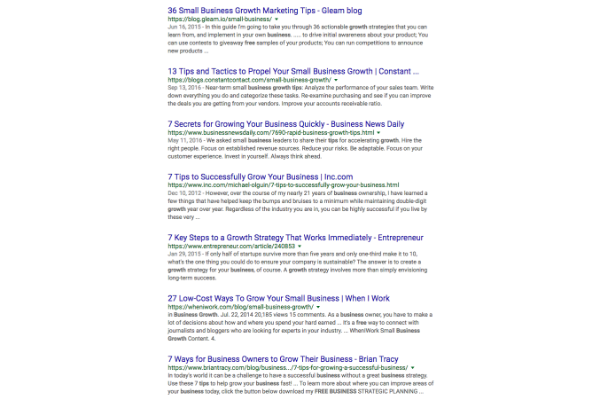
When you put it in, you say, “Wow! Look, it gets 35,000 searches a month; this is great!” What you don’t realize is it will take hundreds and hundreds of backlinks and probably years to even think about ranking on the first page as a new site.
Why?
The competition is fierce. Sites rank on page one right now for that keyword. These sites have been there a while, they have a strong reputation, and Google knows they provide quality information. That’s how they’ve earned the spot. You haven’t earned Google’s trust yet, and it would take a lot for you to outrank the competitors.
Search Intent
Google tells us over and over how important search intent is.
Most people focus on keywords. Counterintuitively, that’s not what you want to do. Instead of looking at what people are typing in, you should be trying to identify what they’re searching for.
This is what “search intent” refers to. It’s the difference between getting a tiny bit of traffic and driving real revenue.
Let’s kick things off with a basic scenario to highlight the difference. You own a job site making money by getting companies to run job post listings on your site. That means you need to get job pages ranking well so people come to your site instead of Indeed or somewhere else.
The more people who find jobs through you, the more you’ll get paid. See what happens with a keyword like “engineering jobs.”
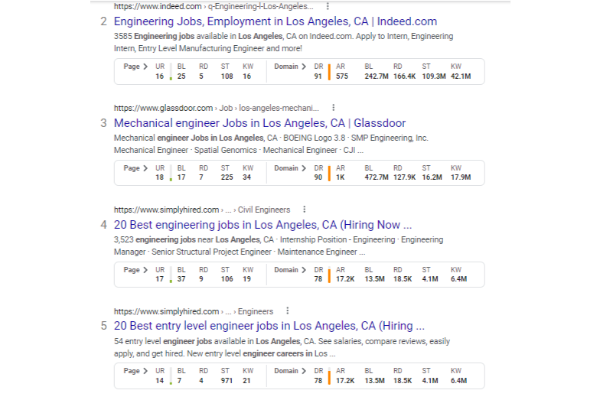
The results are all over the place! Some refer to mechanical engineers, while others focus on software or entry-level positions. The intent behind each search is completely different, which is what you need to pinpoint. What exactly is this user looking for? Which type of engineering job are they interested in?
Google helps us do this by matching search intent with the phrase the user types into the search bar. From your perspective, what matters is you’re creating content and choosing keywords to match the user’s search intent.
4 Tips for Selecting the Best Keywords
Here are my tips for conducting the best keyword research and selection:
- Use tools to help: You can’t do the best keyword research without tools to help you. Tools like Ubersuggest and Ahrefs provide insight into your competition and make your life easier.
- Understand semantics: This is a great way to learn the future of keyword research. Google doesn’t care that much if you insert the exact keyword 15 times; what it wants to match is the intent. If you include one keyword, chances are Google will find 12 others relating to the one. You don’t need to include bass fishing rod, bass fishing rods, fishing rods for bass, and every permutation. Google picks it up for you if your content is good.
- Learn the intent: You must know the intent of the keyword. Understand there is a big difference between what a buyer will type into Google and what a researcher will put into Google. If your content answers a question, you don’t want a buyer. If your content sells something, you don’t want a researcher.
- Spy on the competitors: One of the best ways to perform keyword research is to see what your competitors are doing and follow their lead. If someone is ranking number one for the keyword you want, go into your keyword research tool, input their URL, and see what keywords they’re using with the keyword gap.
HTML
Your site’s HTML is an important piece of the SEO marketing puzzle. Without proper tags, headers, and descriptions, Google will have a hard time figuring out what your content is about and why it should rank higher than the competition.
When people read that HTML is a part of SEO, they start to get scared, but there’s nothing to worry about. You don’t need to understand code, and there is very little involved in the process of changing tags and descriptions. For the most part, changing the HTML from an SEO perspective is as simple as copying and pasting.
Elements of HTML
Now let’s break down some of the factors to pay attention to when it comes to HTML.
Title Tags
One thing a lot of people confuse is the title tag and H1 tag. These are two different headings and should be treated as such. The title tag is what’s displayed in the tab at the top of your browser and shows when your page turns up on Google.
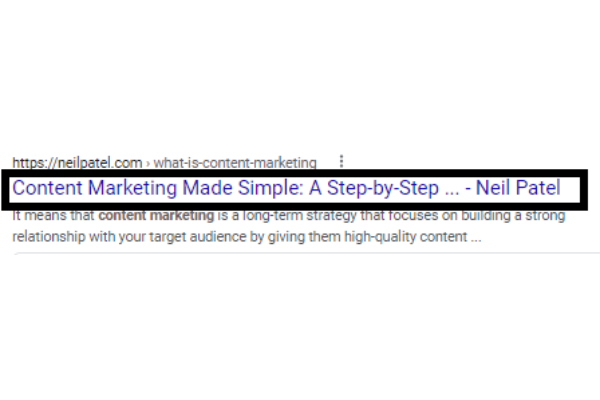
The area in the black box is your title tag. This is the most prominent heading in the search and has a blue or purple color that stands out. You want to use this section wisely by including your main keyword and making the heading enticing so users want to click.
Meta Description
The meta description is the area below that. Here is where you get a chance to tell the searcher what the content is about. It’s important to keyword-optimize this section, and it’s no longer than 160 characters. You want it to display correctly on both mobile and desktop screens.
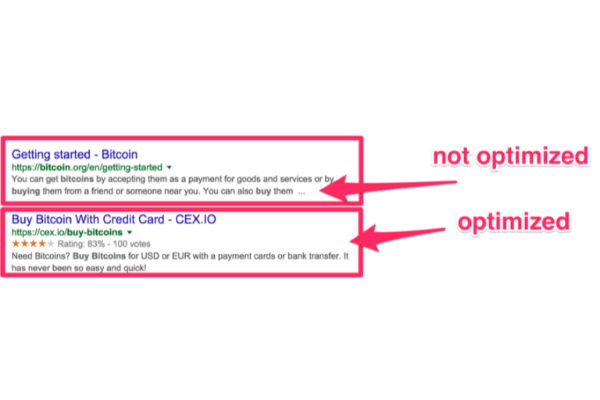
Schema
Schema is the result of a collaboration of several search engines. It’s basically just a subset of specific HTML tags that improves the way the SERPs display your content.
For example, the author of the above example with Bitcoin used a schema to create the rating Google displays on the SERP. It’s a rather small factor but definitely good practice.
When you’re done adding your schema, don’t forget to test your page to make sure everything runs smoothly.
Subheadings
One example of a subheading would be your H1. This is the title of your article and is displayed at the top. While it might just seem like a string of words, it’s important because it’s your H1. It’s your primary header.
This heading tells Google what the article or piece of the content is about. It’s also your opportunity to draw readers in when they first land on the page. You want to use your primary keyword in your H1, but you don’t want to stuff keywords.
I also like to think of my H1 as me inviting someone onto the page. It shouldn’t be transactional or pushy. You want to entice readers to continue down the page with your H1.
Alt Text
Alt text describes an image in your article. All pieces of content have it, but a lot of people don’t make use of it. The point of alt text is so search engines can verbally describe the image to people who are visually impaired. When you write alt text, you want it to properly break down what the image is, but you can also use these for inserting keywords.
URL Slug
Going back to this image again, you’ll see the box is around the phrase “what is content marketing.” This is the URL slug, which is the part of the URL that tells Google what the content is about. These are also important areas for you to insert your most important keyword.
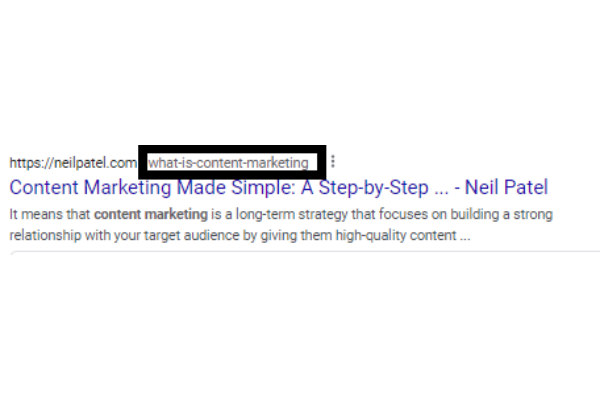
In this example, we used “what is content marketing” to describe the page, and Google should know the article will break down the details of basic content marketing.
4 Tips for Making the Right HTML Improvements
Here are my most important tips to keep in mind as you make HTML improvements to your site:
- Use tools to help you: I keep saying this, but it’s so important. The various SEO marketing tools out there are worth the investment because they will help you identify HTML issues with your site. For example, Ahrefs tells you if a site has duplicate title tags or how many articles are missing meta descriptions.
- Piggyback on the competition: Stealing is bad, but using your top-ranking competitors for inspiration isn’t. If you’re struggling to figure out what you should use for your title tag or meta description, see what the competition is doing.
- Never stuff keywords: There’s nothing worse than a keyword-stuffed meta description that reads horribly. Google will see right through it and may even penalize you if you do it enough.
- Don’t forget H2, H3, and H4 headers: We talked about H1 headers, but don’t forget the rest. These are all important places where you should have your primary keywords to help tell Google which subject your article focuses on.
Site Architecture
A good website architecture leads to a great user experience, which is important for SEO marketing. It focuses on things like fast loading times, a safe connection, and a mobile-friendly design.
Ideally, you’ll map out the architecture of your site before even buying the domain. That allows you to really get into your user’s head and reverse-engineer your way to a great user experience (UX).
ConversionXL has a great guide on how to make sure your UX is effective. You also need to optimize a few things for a great “search engine experience.” The more accessible your website is to Google, the better it will rank.
Elements of Site Architecture
If you’re having a hard time understanding site architecture, the following sections should clear it up for you.
Easy to Crawl
You’ll see the word “crawl” used a lot. This means Google is going through your site to try and figure out what it is. Google identifies important keywords, diagnoses on-site issues, and uses these factors to determine where you rank.
Depending on how well they can index all the pages on your site, they’ll be more likely to report a good result. The thicker the web of links between pages of your site, the easier it is for the spiders to reach all of them, giving the search engine a better understanding of your site.
You can make this job easier for Google by creating a sitemap with a simple plugin if you’re on WordPress or using an online XML sitemap generator.
Your goal should be to make the site as easy to crawl as possible. If Google has a hard time figuring out your site, you’ll have a more difficult time ranking because the AI won’t pick up on all the keywords you’re using.
Duplicate Content
There are a lot of myths around duplicate content and how it hurts your rankings. Many people incorrectly assume that everything on your page should be original, but the fact is, search engines do not penalize websites for duplicate content.
Reposting your content on other websites or publishing your guest posts again on your own site doesn’t hurt your SEO unless you do it the wrong (spammy) way.
For example, if you repost your exact same content to a big outlet like Medium, it might hurt your rankings because Google indexes your Medium article first since it’s on the more authoritative domain. This is often referred to as a “canonicalization” problem, and it might already be happening on your site without you realizing it.
Canonical issues occur when one or more URLs on your site displays similar or duplicate content.
In reality, there’s a lot of duplicate content on the internet. One situation that a lot of site owners run into is having duplicated content that appears on a sidebar. If you post a blog article on your site and have an intro in the sidebar, Google could consider that duplicate content.
There are also instances of duplicate content on two different domains. Content syndication is an example of this. Syndication is when original content is reposted somewhere else. As long as this is done with permission, Google won’t penalize you for it.
Mobile-Friendliness
We know Google indexes for mobile first. This means we need to create a site that performs well on mobile because that will be the most important deciding factor when Google determines how easy it is to crawl your site.
If you go into your Google Search Console, you’ll find a lot of information about what Google thinks of your site.

Taking a look at the above image, you’ll see this site has one issue for mobile usability. If you see issues like this in your Google Search Console, you’ll want to fix them right away.
Page Speed
With the implementation of Core Web Vitals, Google puts a lot of emphasis on page speed and usability. If your site loads too slow or certain elements load slowly, Google may penalize you or make it more difficult for you to outrank your competition.
Once again, the Google Search Console will provide you this information so you don’t have to go digging for a tool to tell you what your page speed is.
HTTPS and SSL
Security and safety are the important ranking factors. If Google thinks your site is spammy or sketchy, it’s not going to give you a first-page ranking.
One way it’s helped filter the good from the bad is through SSL certificates and HTTPS. It’s simple to set these up and can give you the little lock next to your URL and HTTPS before the URL string. This is an important trust signal, and while it doesn’t provide that much SEO juice, it’s a best practice that will benefit your long-term goals.
3 Tips to Improve Your Site Architecture
There are three important factors to keep in mind as you improve your site’s architecture. Take a look.
1. Make sure you understand Core Web Vitals: The most important piece of the puzzle is Core Web Vitals. You need to understand what these are, how they impact your rankings, and what you can do about them. Read more about it and make sure you’re making all the right moves on your site.
2. Get a sitemap: Use something like the WordPress sitemap plugin if you have an extensive site. A great example of this is for a real estate website. Sites like this are huge because they have thousands of pages for all their real estate listings. To make matters worse, the pages are constantly changing as houses are bought and sold. Getting a sitemap would help the real estate site rank for each address, dramatically increasing the number of keywords they rank for, their traffic, and their domain authority.
3. Fix canonicalization issues: The feature that causes duplicate content is often built into the site, but there are ways to fix canonicalization issues like these. The exact solution depends on what’s causing the original issue. It could be as simple as removing a line of code or as complicated as restructuring your entire site to prevent duplicate content.
Even though Google Search Console or another tool says you have thousands of duplicate content errors, you really just have one big root cause.
If you have multiple versions of the same page, the canonical tag can help you specify which content is the original. All you have to do is drop in a single line of code that references the original page URL, like this:

Fortunately, plugins like Yoast SEO make this simple. You can set the default page or post version as the canonical so it always adds this line by default. Alternatively, you can specify it manually under the advanced settings options for each page or post:

Another time-saving WordPress tip is to use the Quick Page/Post Redirects plugin. This one is helpful if you’ve had old pages morph into new ones, which often leaves behind a wave of broken links. Install the plugin, and you can add the old URLs in bulk and then the new version of each page.
Use this one with the Broken Link Checker plugin to see which URLs you need to redirect.
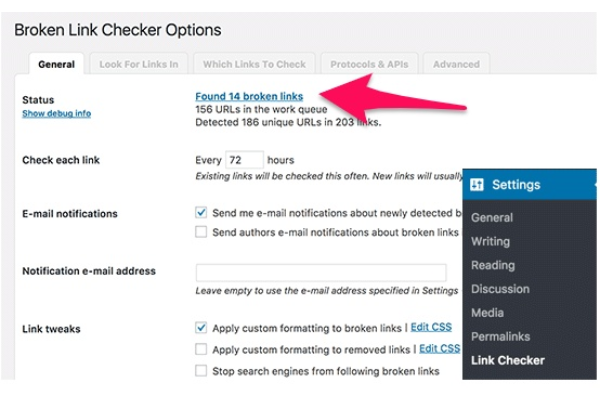
Most SEO-focused tools also crawl your site like search engines to audit these common issues.
Duplicate content and broken links (or 404 errors) are the two most common crawl errors plaguing most websites.
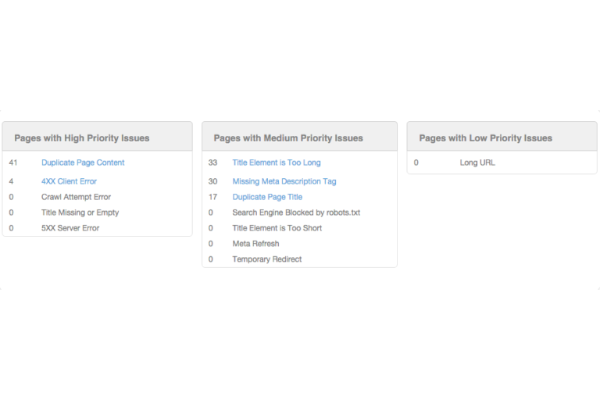
If you’re not on a content management system like WordPress, you’re going to have to edit the .htaccess file of your site to include 301 redirects. I’d strongly recommend educating yourself about 301 redirects and getting some professional help in this case.
Trust
PageRank, the famous formula the founders of Google invented, certainly isn’t the only measure they take when ranking pages in the top ten search results.
Trust is getting increasingly important, and most of the recent Google updates have hit spammy and obscure websites. TrustRank is a way for Google to see whether your site is legit or not. For example, if you look like a big brand, Google is likely to trust you. Quality backlinks from authoritative sites (like .edu or .gov domains) also help.
Elements of Trust on Your Site
Now, there are three parts to building trust: authority, bounce rate, and domain age.
Authority
Google determines the overall authority of your site by a mix of two kinds of authority you can build:
- Domain authority, which has to do with how widespread your domain name is. Coca-cola.com is very authoritative, for example, because everyone has heard of it.
- Page authority, which relates to how authoritative the content of a single page (for example, a blog post) is.
You can use this tool to check your authority on a scale of 1-100.
Two other popular authority metrics are the domain and page authority numbers from Moz.
Moz also bases this score out of 100, but it’s a weighted scale.
That means it’s relatively easy to go from 0-20. However, anything over 50-60 is pretty high, and 80-90 is often the highest in a particular industry.
Bounce Rate
Your bounce rate is simply a measure of how many people view only one page on your site before immediately leaving again.
Content, loading times, usability, and attracting the right readers are all part of decreasing your bounce rate. The math is simple—the right readers will spend more time on a site that loads fast, looks good, and has great content.
Video is another great way to do so, but you need your video content to stand out and deliver. Most importantly, your content needs to provide what the reader expects. They need to land on your page and get exactly what they wanted as soon as possible. If you can do that, most people will stay on the site long enough, which will tell Google your site is topically relevant.
Domain Age
Sometimes the most respected person in the room is the oldest right? The same goes for the internet. If a website has been around for a while, producing consistent content and doing so in a way that is pleasing to the search engines, it’ll rank higher than a new site no matter what.
3 Tips to Build More Trust
Here are some of my best tips to help you build more trust on your site:
- Be patient: Trust isn’t something that happens overnight. Sometimes, you just need to be patient and realize Google isn’t in any hurry to crawl your site. One way you can get them to do it sooner is by making slight changes on the site and requesting indexing in Google Search Console. This will push Google to act, but it still doesn’t guarantee anything.
- Understand intent: A big part of SEO marketing is understanding what users want, not what you want them to want. When someone searches for something in Google, they’re looking to accomplish something. If you provide that solution, make sure you provide the whole solution; otherwise, they’ll get to your site, realize it’s not good enough, and move on.
- Give them what they want: One great tip to prevent users from bouncing is to give them what they want as soon as they land on your site. Most people aren’t looking to read an entire article, instead, they want an answer, and the sooner you give it to them, the better.
Links
The importance of a solid link profile will vary from expert to expert. I still believe links are one of the most important ranking factors Google has for you.
One problem a lot of SEOs have is they don’t understand how to do it the right way. If you use the wrong tactics, you’re setting yourself up for failure from the beginning. If you choose to take the long-term strategy and build links the right way, it might take a bit longer, but you’ll thank yourself down the road.
Elements of Link Building
Here are the most important factors to consider when building links for your site:
Link Quality
While links are not everything, when looking at links, their quality is everything. It matters much more than the number of links you have. Building quality backlinks is about reaching out to the right sources and offering value in exchange for a solid link. There are many ways to build links the right way, so Google pays those who do it correctly.
Most people only look at the total number of links, but that’s a huge mistake for a few reasons:
- Search engines might ignore the vast majority of links if they’re low-quality or spammy.
- Links from brand new sites are worth more than repeat links from existing sites.
- Links from other websites are worth more than a bunch of links from your own site (from one page to another).
How do you identify a bad link from a good link?
Google expects the links you get pointing to your site to be relevant. Going over to Fiverr and purchasing a gig that offers 10,000 links for $100 isn’t going to yield the results you expect. They’re going to be crappy profile links on things like Myspace and Soundcloud, which probably aren’t relevant to your niche.
Another thing Google looks out for sites that charge for links. You can do a quick “site: write for us” search, and it might bring results that look something like this.
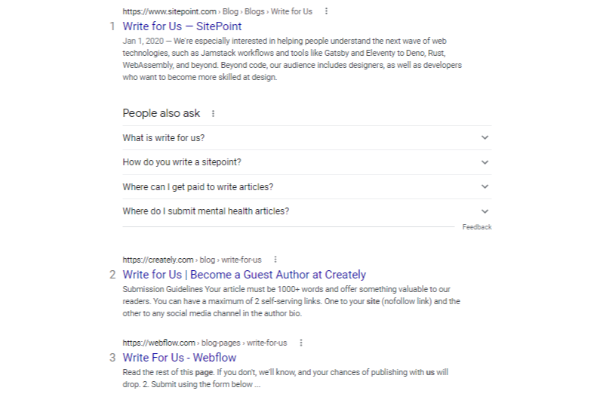
Some of these sites may charge you to guest post on their site in exchange for a link. Google doesn’t like this because it becomes easy for those with a big bank to game the system.
The goal of link building is for Google to reward those who provide value in exchange for a link. You want to write a guest post on a site with people interested in your expertise.
The site you choose to write a guest post for should also have traffic of its own. When the site has traffic, that’s going to flow more link juice in your direction since people are actually seeing what you’re contributing.
Anchor Text
Anchor text is the text used beneath the link. The goal is for the text to appear as naturally as possible in the article. You want to have a variety of different types of anchor text because they each have their own place in the SEO realm.
The one thing you don’t want to do is have a bunch of text that says “click here” pointing to your site. Instead, if you wrote an article about raised garden beds and you’re trying to get a link to it, you might want the anchor text with a link on it to actually say “raised garden beds.” Doing this helps tell Google more about what is to come when someone clicks through.
Number of Links
Lastly, the number of total links you have matters as well, and you need to build high-quality backlinks at scale over time.
We already touched on this, but it bears repeating: It’s not just total links you’re after. At the end of the day, the site with the most high-quality links will usually have a better edge. However, it also depends on the pages you’re getting links to. Links to your homepage are good, but most natural links won’t be to a homepage unless they’re mentioning your brand name specifically.
What you often find is people link to pages or posts on your site. If possible, you want to make sure the right sources are linking to the right pages. What you don’t want is for your privacy policy to be your most linked-to page. There’s nothing to buy from that page! Visitors can’t give you their information or subscribe or buy.
That’s the first mistake.
The second is not considering how and where those links are coming from. One of Crazy Egg’s most popular features is the heatmap, which helps people pinpoint which site elements are aiding conversions and which are distracting people from converting. If you’re trying to get links to this page, you want to get links from landing pages or conversion-related sources.
That might change for other feature pages like Recordings. Here, a design-related link wouldn’t make as much sense. It’s not as contextually relevant. However, if the page or post were speaking about usability or interface design, then it would be a decent fit.
The quality source of the links you get matters, but so, too, does the place they’re linking to.
3 Tips to Improve Your Link Profile
Now let me provide you with some actionable steps you can take to improve your link profile and ensure you’re getting the most link juice from your efforts.
- Don’t take shortcuts: There are no shortcuts in link building; you need to take the time and build them the right way. This involves having conversations with people, pitching yourself, and telling them how you can provide value to their site. Look for broken link opportunities, find sites that are relevant to your niche, and pitch them via email or social media.
- Remove hazardous links: Google has something called the disavow tool that allows you to remove links that might be hurting your ability to rank. You’ll want to use this tool carefully because disavowing a ton of links could actually harm your site. Removing links that are no longer relevant or that maybe popped onto your profile by accident can help clean up your link profile.
- Don’t forget internal linking: Internal linking is an important piece of the puzzle too; we shouldn’t only worry about external links. Of course, external links are important, but creating a web of topics within the same niche helps Google crawl your site. Google pays a lot of attention to search intent and the overall comprehensiveness of a piece of content. If you can solve everyone’s problems in one place with a cluster of articles that cover a topic from front to back, Google will reward you.
Personal
The next category of off-page SEO that’s worth taking a look at is personal factors. I’m talking about demographics and location. These factors automatically impact the way someone responds to your content, but your SEO efforts also behave differently from one area of the globe to another.
While most of these are out of your control, you can do a few things to increase your chances of reaching a certain audience. There’s no “one-size-fits-all” option when it comes to personal SEO factors.
Elements of Personal SEO Factors
Here are the biggest factors impacting personal SEO:
Country
All searchers see results relevant to the country they’re in. Open times of recommended stores and restaurants appear according to your time zone.
Search engines interpret words differently. Someone searching for “comforter” in the U.S. will see blankets for their bed, whereas someone in the U.K. might see pacifiers because that’s what the term means there. A way to tell Google you want to target certain countries is, of course, by including them as keywords.
However, first, ask yourself if it’s worth it to go multinational. There are different competition levels from country to country. Remember how keyword selection depends largely on the competition already ranking? Well, Google Canada is going to have different results than Google Brazil. Each country might have different levels of difficulty. A multilingual site not only exposes your information to more people in their native language, but it could also help you rank easier in other places.
Creating multilingual content is one of the easiest ‘quick wins’ I’ve seen. However, pulling it off isn’t easy. Most of the web’s translation plugins aren’t very good. Many will promise to automatically translate your content into almost any language, but the end result isn’t natural.
Personally, I’d rather pay a little more to have native-speaking people help translate the content. The quality and accuracy increase, which means people stick around longer, and my site usage data and rankings go up.
City
Geo-targeting goes even further, down to the city level. That’s why you usually see results from right around the block when you search for a fast-food chain. Using city names as keywords helps, but don’t paint yourself into a corner, or you’ll end up looking like you’re only a local authority.
That said, if you are a local authority and your business primarily deals in the local area, you want to capitalize on this with great local SEO.
3 Tips to Improve the Personal Factors
I have three simple tips to help you improve the personal factors impacting your SEO:
- Understand your customer avatar: Only you can understand who your customer is, and if you don’t have a persona of your ideal customer, that’s the first step to personal SEO. What does your customer want? Why are they looking for you? What do they expect when they land on your site? If you answer these questions properly, you should be able to give the customer exactly what they expect. When you do that, Google rewards you because people spend more time on your site and interact with the elements on the site.
- Produce multilingual content: Having content in different languages isn’t as hard as you think. You’re breaking down so many barriers when you do this by allowing people who aren’t native English speakers to absorb whatever value you offer.
- Research keywords in other countries: Almost all of the keyword research tools allow you to conduct research for other countries. If you’re targeting people outside of your native country, you need to perform the right keyword research to reach those people.
Social
Lastly, let’s take a look at the social factors of off-page SEO. Besides social signals directly from the searcher, there are other ways good results on social media will help you rank better.
Whether that’s directly through more links or indirectly through a PR boost, social matters.
Elements of Social for SEO
There are two main factors of influence:
Quality of Shares
SEO marketing and social media marketing go hand-in-hand because the goal is to tell Google how great you are. If people are out there sharing your content and spreading the reach further, what does that tell Google?
It tells them people like what you have to offer, and you’re providing great value to people. This is good for Google.
Number of Shares
The secondary social metric is the number of shares. Landing a viral hit is every marketer’s dream, but it is overrated. There are a lot of tips and hacks out there, but the truth is a little simpler: Make awesome content.
That means different things to different people. For example, in the marketing space, I’ve found long-form content almost always outperforms short-form. Now, consider celebrity gossip sites for a second. No one wants to slog through a whole bunch of words. The opposite is almost true here. Their audience wants something succinct with a lot of drama. They want more videos and images with less text.
This is the bread and butter of sites like Buzzfeed and TMZ. They draw you in with these big headlines that make something sound way more exciting than it is. How many people do you think share that without even reading the article?
Probably a lot.
To get shares in the SEO game, you simply need to create awesome content that people like to read, on a site where people are reading. That’s again why I said before how important it is to guest post on sites with an actual readership. If you’re guest posting somewhere with no readers, do you think the post will get any shares?
3 Tips to Improve Your Social Sharing
Here are three tips to get more shares on social media:
- Create great content: Creating the best quality content is the way to get shares, plain and simple. Google spends plenty of hours and more money than you can fathom preventing people from gaming the system. It’s a simple concept, really. It’s an exchange of value. Everything in business is an exchange of value, and the same goes for SEO marketing. Provide valuable content to Google, and Google will reward you.
- Be consistent: Consistency is extremely important in SEO and social media. If you post once every three months, not only will social media algorithms hate you, there won’t be anyone around to share the content because it’s been so long since your previous post. Posting consistently on social media requires you to have new content to share on a regular basis as well. It all goes full circle.
- Make it easy: There are many plugins to promote social sharing, so you need to use something on your site. If the reader can’t figure out a simple way to share your post on social media, they’ll likely move on.
Google’s EAT Guidelines
As you evaluate your SEO practices, you can analyze what Google uses to train human content evaluators. See, in addition to a massive amount of algorithms, Google employs Quality Raters to improve the search engine experience for everyone.
Google explains in its evaluator guidelines that a high-quality page needs to possess a high level:
- expertise
- authority
- trustworthiness
Or, as this set of guidelines is more commonly known, EAT.
Subjective review of what makes a piece of content display EAT depends on the topic, background of those posting, reputation of the website, and more.
Though you may not have control over all of the factors from the get-go, keeping EAT in mind as you create content can help ensure your content is headed in that direction.
4 Tips for Improving Your EAT Score
- Do Your Research: This may seem obvious, but the best way to truly portray expertise, authority, and trustworthiness is to share accurate information. Bring in expert interviews or guest posts, when you’re able to. Make sure that the information you are sharing is correct, in context of the topic and for the audience who will be reading it. Doing otherwise is the quickest way to score low with these criteria.
- Be Thorough: Now that you’re sure that your information is accurate, you’ll also want to make sure it’s comprehensive. Answering a question with a short or simplistic post can feel dismissive. In order to be seen as an expert, your content needs to leave the reader feeling satisfied and equipped.
- Speak to What You Know: When you are developing content for your website, stick with what you’re about as a brand. Avoid shiny object syndrome and getting lost in content that isn’t relevant to what your website is about. Sticking to your topic of expertise will help build your reputation as the place to go for information about that.
- Speak to Your Audience’s Need: On a similar note, you’re only going to be able to build trustworthiness and authority in the mind of a reader if you actually speak to the topic that readers are coming to read. What is it about the topic that they need to know about? What problems can you solve? There’s a difference between being able to speak in-depth on a topic because you know it so well and being able to teach it in ways that feel accessible and relevant. The latter will help readers actually see you as an authority and someone they can trust.
SEO Marketing: Putting It All Together
We covered a ton of information in this guide, and I can understand if you feel a bit overwhelmed. Let’s make things simple and quickly touch on the most important points so you can walk away feeling relieved and excited about your journey with SEO for marketing.
Black Hat Vs. White Hat SEO
Black hat wix seo expert is using slimy tactics like buying links, stuffing keywords, and duplicating content. While these things work in the short-term, they won’t work long-term. You might see a boost in traffic and revenue for a month or two until Google figures you out and blacklists your site for good.
White hat SEO is the way to go. It takes longer, but it implements the right tactics that will pay you for years to come.
Keyword Research and Selection
Having the right keywords on your website is the main way Google figures out what the site is about. Using tools like Ubersuggest can help you find the right keywords that are relevant to your topic.
Make sure you don’t force them where they don’t belong, and remember creating quality content is most important above all else.
HTML
Title tags, meta descriptions, alt text, and headers are important pieces of the SEO marketing puzzle. You’ll use these to tell Google more about your content and what readers can expect when they land on your site.
Site Architecture
The architecture of your site focuses on the design and functionality of it. If users can’t navigate the site easily, it loads too slow, and certain elements are hard to get to, it will be more difficult for Google to navigate the site as well.
Trust
People need to trust your site, and having features like SSL certificates and HTTPS is the industry standard now. You can’t have a website without these and expect to rank because Google expects this.
In addition to the backend stuff, you want to have trust signals on your site that show people you’re a professional and not looking to scam them in any way.
Links
Link building is crucial but difficult and requires a lot of time and effort. The good news is, there’s a lot of people out there doing it wrong. This opens the door for SEOs who are willing to go the extra mile to build links the right way.
Don’t get spammy gigs on Fiverr that promise 10,000 links. They’re scams. You need to build each link manually on sites in your niche that have their own traffic.
Personal
Make sure you understand your audience and what they want from you. Every customer has an expectation when they land on your site, and it’s up to you to fulfill that need or desire.
Social
Social media and SEO marketing work well together, so don’t neglect the social aspect because it can provide a nice boost to your SEO efforts. It takes a lot to rank on Google, and getting ample social shares can really help show Google you’re in it for the long haul and willing to do whatever it takes.
EAT (Expertise, Authority, Trustworthiness)
This is a gut check you can use to ensure that your content is connecting well with people, based on a criteria Google uses for real-world evaluators.
Create content that shows a level of understanding on a topic and reflects a reputation for a top source of information about it. Ask yourself whether the content you are putting out there is helping you build that reputation and allowing your readers to trust you on the topic.
SEO and Google Algorithm Updates
SEO may often feel unapproachable or impossible because of the term “algorithm.” An algorithm is a series of operations a search engine uses to calculate and rank websites based on when someone uses a specific search query.
You may have heard algorithms are always changing, and, to some degree, that’s true. Google makes what they call “core updates” multiple times a year to better serve those searching online. You can explore a history of Google algorithm updates on the Moz website.
However, while Google may often make tweaks, your main concern should continue creating high-quality content, using relevant keywords, and building reputable backlink relationships. You shouldn’t try to “game the system” when it comes to Google’s algorithms, as a major reason for the continual updates is to weed people who do that out. You could actually hurt your rankings by focusing too much on the algorithm and not enough on your content.
SEO Marketing Frequently Asked Questions
SEO Marketing Guide: Conclusion
I hope you got a lot out of this guide because there is a lot of information here. Be sure to refer back as you make your way through your SEO marketing journey. The most important thing to remember about SEO is there are no shortcuts in this game. You need to do things the right way and go the extra mile because that’s how you’ll stand out.
Expect to devote at least six months to it if you want to see results. Those who say SEO is a “set it and forget it” strategy are wrong. You’ll want to stay on top of your content, update it regularly, and continue creating great new content to refresh your site and show Google you’re still active.
What do you think is the most important factor in SEO marketing?
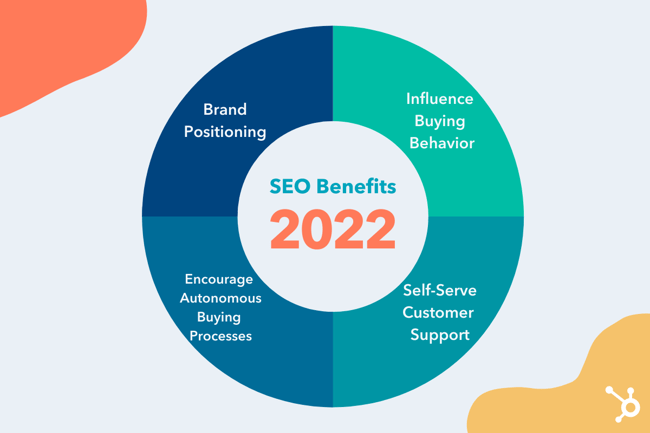
No comments:
Post a Comment